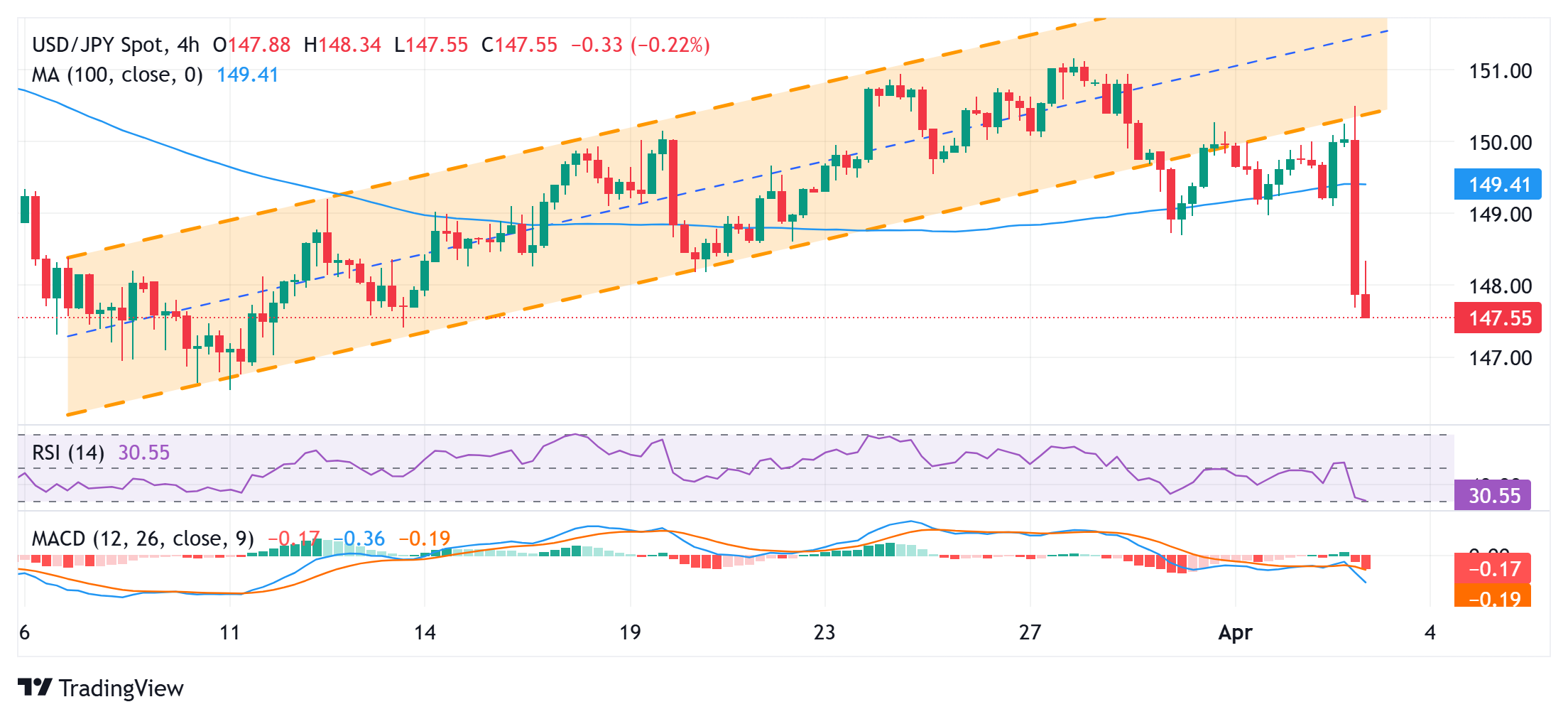- The Japanese Yen rallies across the board amid Trump’s tariff-inspired global flight to safety.
- The narrowing of the US-Japan rate differential drives flows toward the lower-yielding JPY.
- The divergent BoJ-Fed expectations support prospects for a further USD/JPY depreciation.
The Japanese Yen (JPY) builds on its strong intraday gains amid the global flight to safety, fueled by growing concerns over the potential economic fallout from US President Donald Trump’s sweeping reciprocal tariffs. This, along with a broadly weaker US Dollar (USD), drags the USD/JPY pair to over a three-week low, around the 147.20-147.15 region during the Asian session on Thursday.
Meanwhile, expectations that the Bank of Japan (BoJ) will raise interest rates further mark a big divergence in comparison to bets that the Federal Reserve (Fed) will resume its rate-cutting cycle soon amid a tariff-driven US economic slowdown. This would result into a further narrowing of the rate-differential between Japan and the USD, which should further underpin the lower-yielding JPY.
Japanese Yen benefits from heightened safe-haven demand after Trump’s trade tariffs
- The global risk sentiment took a turn for the worst after US President Donald Trump unveiled reciprocal tariffs of at least 10% on all imported goods, sparking concerns over slowing global economic growth.
- Stock markets around the world plunged in reaction to the US tariffs announcement, lifting the safe-haven Japanese Yen to a three-week high against the US Dollar during the Asian session on Thursday.
- The anti-risk flow saw most global government bond yields fall, with the yield on the benchmark 10-year US government bond tumbling to the 4.0% neighborhood and hitting a fresh year-to-date low.
- Traders lifted bets that the Federal Reserve will start lowering borrowing costs at the June policy meeting and deliver a total of three 25-basis-point reductions to the policy rate by the end of this year.
- This, to a larger extent, overshadows Wednesday’s upbeat US ADP report, which showed that private-sector employers added 155K jobs in March, far more than the 105K expected and 84K previous.
- Meanwhile, worries about the impact of harsher-than-expected US tariffs on Japan’s economy forced investors to scale back their bets that the Bank of Japan would raise policy rate at a faster pace.
- However, the incoming macro data, including strong consumer inflation figures from Tokyo released last Friday, keeps the door open for further BoJ rate hikes, which, in turn, underpins the JPY.
- Traders now look forward to Thursday’s US economic docket – featuring Weekly Initial Jobless Claims and the ISM Services PMI. The focus, however, will remain on trade-related developments.
USD/JPY bears might now aim to challenge multi-month low, around 146.55-146.50 area

From a technical perspective, the intraday slump below the 100-period Simple Moving Average (SMA) on the 4-hour chart comes on top of the recent breakdown through a multi-week-old ascending channel. This, along with bearish oscillators on the daily chart, supports prospects for a further near-term depreciation for the USD/JPY pair. Hence, a subsequent fall towards the 147.00 mark, en route to the 146.55-146.50 region or a multi-month low touched in March, looks like a distinct possibility.
On the flip side, any attempted recovery might now confront hurdle near the 148.00 mark. A sustained move, however, could trigger a short-covering rally towards the 148.65-148.70 region. That said, a further move up, is likely to attract fresh sellers near the 149.00 mark and cap the USD/JPY pair near the 149.35-149.40 region, or the 100-period SMA on the 4-hour chart. The latter should act as a key pivotal point, which if cleared might negate the negative outlook and pave the way for further gains.
Japanese Yen FAQs
The Japanese Yen (JPY) is one of the world’s most traded currencies. Its value is broadly determined by the performance of the Japanese economy, but more specifically by the Bank of Japan’s policy, the differential between Japanese and US bond yields, or risk sentiment among traders, among other factors.
One of the Bank of Japan’s mandates is currency control, so its moves are key for the Yen. The BoJ has directly intervened in currency markets sometimes, generally to lower the value of the Yen, although it refrains from doing it often due to political concerns of its main trading partners. The BoJ ultra-loose monetary policy between 2013 and 2024 caused the Yen to depreciate against its main currency peers due to an increasing policy divergence between the Bank of Japan and other main central banks. More recently, the gradually unwinding of this ultra-loose policy has given some support to the Yen.
Over the last decade, the BoJ’s stance of sticking to ultra-loose monetary policy has led to a widening policy divergence with other central banks, particularly with the US Federal Reserve. This supported a widening of the differential between the 10-year US and Japanese bonds, which favored the US Dollar against the Japanese Yen. The BoJ decision in 2024 to gradually abandon the ultra-loose policy, coupled with interest-rate cuts in other major central banks, is narrowing this differential.
The Japanese Yen is often seen as a safe-haven investment. This means that in times of market stress, investors are more likely to put their money in the Japanese currency due to its supposed reliability and stability. Turbulent times are likely to strengthen the Yen’s value against other currencies seen as more risky to invest in.

























